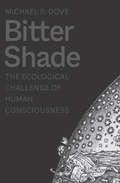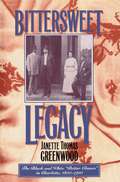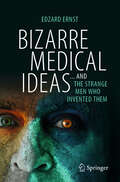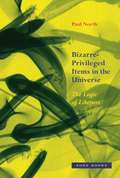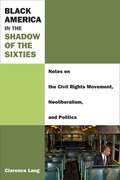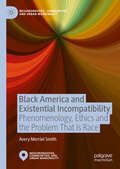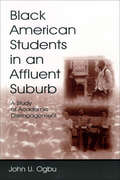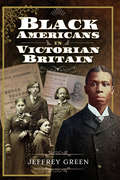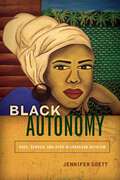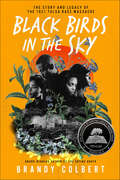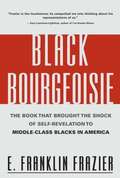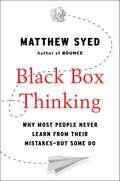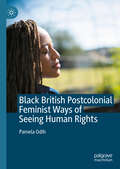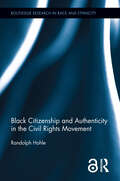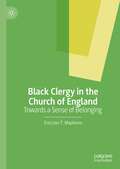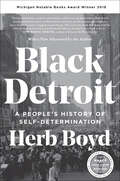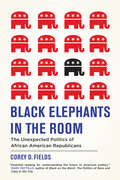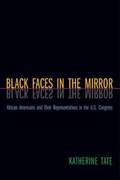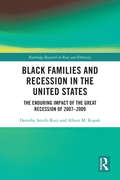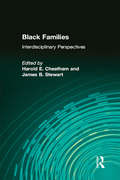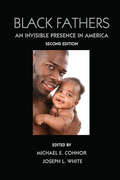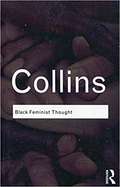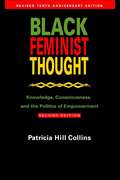- Table View
- List View
Bitter Shade: The Ecological Challenge of Human Consciousness (Yale Agrarian Studies Series)
by Michael R. DoveA seminal anthropological work on the paradoxical relationship between human consciousness and the environment This book asks an age-old question about the relationship between human consciousness and the environment: How do we think about our own thoughts and actions? How can we transcend the exigencies of daily life? How can we achieve sufficient distance from our own everyday realities to think and act more sustainably? To address these questions, Michael R. Dove draws on the results of decades of research in South and Southeast Asia on how local cultures have circumvented the &“curse of consciousness&”—the paradox that we cannot completely comprehend the ecosystem of which we are part. He distills from his ethnographic, ecological, and historical research three principles: perspectivism (seeing oneself from outside oneself), metamorphosis (becoming something that one is not), and mimesis (copying something that one is not), which help a society to transcend the hubris and myopia of everyday existence and achieve greater insight into its ecosystem.
Bittersweet Legacy
by Janette Thomas GreenwoodBittersweet Legacy is the dramatic story of the relationship between two generations of black and white southerners in Charlotte, North Carolina, from 1850 to 1910. Janette Greenwood describes the interactions between black and white business and professional people--the 'better classes,' as they called themselves. Her book paints a surprisingly complex portrait of race and class relations in the New South and demonstrates the impact of personal relationships, generational shifts, and the interplay of local, state, and national events in shaping the responses of black and white southerners to each other and the world around them. Greenwood argues that concepts of race and class changed significantly in the late nineteenth century. Documenting the rise of interracial social reform movements in the 1880s, she suggests that the 'better classes' briefly created an alternative vision of race relations. The disintegration of the alliance as a result of New South politics and a generational shift in leadership left a bittersweet legacy for Charlotte that would weigh heavily on its citizens well into the twentieth century.
Bizarre Medical Ideas: ... and the Strange Men Who Invented Them
by Edzard ErnstThis book focuses on the individuals who invented specific forms of alternative medicine. Examples are Hahnemann (homeopathy), Still (osteopathy), Schulz (autogenic training). In total, about 40 such personalities are included in the book. They have all led unusual lives, and the book explores their journey towards their inventions. Certain characteristics seem to emerge: · They are all male! · Many originated from Europe · Most of them are white · Many gave their name to the therapy · Many inventions are relatively recent · Many inventors are not doctors · Most inventors claim to have found a panacea · Many adhere to vitalistic ideas · Almost all of the inventors are fully convinced of their invention · Inventions are often based on personal experience · The inventions tend to be implausible even by the standards of their time The book explores all these themes and, where appropriate, contrasts them with the corresponding situation in conventional medicine.
Bizarre-Privileged Items in the Universe: The Logic of Likeness
by Professor Paul NorthAn imaginative new theory of likeness that ranges widely across history and subjects, from physics and evolution to psychology, language, and artA butterfly is like another butterfly. A butterfly is also like a leaf and at the same time like a paper airplane, an owl’s face, a scholar flying from book to book. The most disparate things approach one another in a butterfly, the sort of dense nodule of likeness that Roger Caillois once proposed calling a “bizarre-privileged item.” In response, critical theorist Paul North proposes a spiritual exercise: imagine a universe made up solely of likenesses. There are no things, only traits acting according to the law of series, here and there a thick overlap that appears “bizarre.”Centuries of thought have fixated on the concept of difference. This book offers a theory that begins from likeness, where, at any instant, a vast array of series proliferates and remote regions come into contact. Bizarre-Privileged Items in the Universe follows likenesses as they traverse physics and the physical universe; evolution and evolutionary theory; psychology and the psyche; sociality, language, and art. Divergent sources from an eccentric history help give shape to a new trans-science, “homeotics.”
Black America In The Shadow Of The Sixties: Notes On The Civil Rights Movement, Neoliberalism, And Politics
by Clarence LangThe 1960s, including the black social movements of the period, are an obstacle to understanding the current conditions of African Americans, argues Clarence Lang. While Americans celebrate the current anniversaries of various black freedom milestones and the election of the first black president, the effects of neoliberalism since the 1970s have been particularly devastating to African Americans. Neoliberalism, which rejects social welfare protections in favor of individual liberty, unfettered markets, and a laissez-faire national state, has produced an environment in which people of color struggle with unstable employment, declining family income, rising household debt, increased class stratification, and heightened racial terrorism and imprisonment. The book argues that a reassessment of the Sixties and its legacies is necessary to make better sense of black community, leadership, politics, and the prospects for social change today. Combining interdisciplinary scholarship, political reportage, and personal reflection, this work sheds powerful light on the forces underlying the stark social and economic circumstances facing African Americans today, as well as the need for cautious optimism alongside sober analysis.
Black America and Existential Incompatibility: Phenomenology, Ethics and the Problem That Is Race (Neighborhoods, Communities, and Urban Marginality)
by Avery Merriel SmithWithin the context of W.E.B. Du Bois’ question “How does it feel to be a problem?”, this volume examines the “problem” using a phenomenological approach, that is to say, in terms of one’s experience of such. More specifically, the author explores three points: the Black person’s experience of being a problem for White America; her experience of White America as a problem or obstacle for their survival and ability to thrive; and her experience of navigating, negotiating and surviving a world that is presented as a duality. This book deconstructs the world(s) that the Black person experiences by first understanding her as a “Dasein” (the Heideggerian concept of a being that is aware of its being in the world and aware of other beings that are in the world it experiences). In considering the Black person as a Dasein, the author affirms the intrinsic value of her being and, therefore, validates the experience she has of the world in which she finds herself. Finally, this volume incorporates Emmanuel Levinas’ philosophy of the face and Paul Ricoeur’s study of the self to help craft an understanding of the ontology of human relationship to support the advocacy for an ethical encounter between the Black person and those whom she encounters in both the Black world and the White world in which she must navigate and concurrently exist.
Black American Students in An Affluent Suburb: A Study of Academic Disengagement (Sociocultural, Political, and Historical Studies in Education)
by John U. Ogbu With the DavisJohn Ogbu has studied minority education from a comparative perspective for over 30 years. The study reported in this book--jointly sponsored by the community and the school district in Shaker Heights, Ohio--focuses on the academic performance of Black American students. Not only do these students perform less well than White students at every social class level, but also less well than immigrant minority students, including Black immigrant students. Furthermore, both middle-class Black students in suburban school districts, as well as poor Black students in inner-city schools are not doing well. Ogbu's analysis draws on data from observations, formal and informal interviews, and statistical and other data. He offers strong empirical evidence to support the cross-class existence of the problem. The book is organized in four parts: *Part I provides a description of the twin problems the study addresses--the gap between Black and White students in school performance and the low academic engagement of Black students; a review of conventional explanations; an alternative perspective; and the framework for the study. *Part II is an analysis of societal and school factors contributing to the problem, including race relations, Pygmalion or internalized White beliefs and expectations, levelling or tracking, the roles of teachers, counselors, and discipline. *Community factors--the focus of this study--are discussed in Part III. These include the educational impact of opportunity structure, collective identity, cultural and language or dialect frame of reference in schooling, peer pressures, and the role of the family. This research focus does not mean exonerating the system and blaming minorities, nor does it mean neglecting school and society factors. Rather, Ogbu argues, the role of community forces should be incorporated into the discussion of the academic achievement gap by researchers, theoreticians, policymakers, educators, and minorities themselves who genuinely want to improve the academic achievement of African American children and other minorities. *In Part IV, Ogbu presents a summary of the study's findings on community forces and offers recommendations--some of which are for the school system and some for the Black community. Black American Students in an Affluent Suburb: A Study of Academic Disengagement is an important book for a wide range of researchers, professionals, and students, particularly in the areas of Black education, minority education, comparative and international education, sociology of education, educational anthropology, educational policy, teacher education, and applied anthropology.
Black Americans in Victorian Britain
by Jeffrey GreenThe first study of its kind, exploring the experiences of some of the black American citizens who ventured forth to Britain in the nineteenth century. With the arrival of black Americans in Britain during the Victorian era, residents of villages, towns, and cities from Dorchester to Cambridge, Belfast to Hull, and Dumfries to Brighton heard about slavery and repression in the US, and learned of the diverse ambitions and achievements of black Americans both at home and overseas. Across the country, numerous publications were sold to the curious, and lectures were crowded. Ultimately, many of these refugees settled in Britain; some worked as domestic servants, others qualified as doctors, wrote books, taught, or labored in factories and on ships while their youngsters went to school. We might not think of black immigrants when we consider the population of Victorian Britain, but this is a shameful oversight. Their presence was important and their stories, recorded here, are both fascinating and powerful. Black Americans in Victorian Britain documents the experience of refugees, settlers, and their families as well as pioneering entertainers in both minstrel shows and stage adaptations of the 1850s bestselling novel Uncle Tom&’s Cabin. This is a timely and engaging new perspective on both Victorian and Afro-American history.
Black Autonomy: Race, Gender, and Afro-Nicaraguan Activism
by Jennifer GoettDecades after the first multicultural reforms were introduced in Latin America, Afrodescendant people from the region are still disproportionately impoverished, underserved, policed, and incarcerated. In Nicaragua, Afrodescendants have mobilized to confront this state of siege through the politics of black autonomy. For women and men grappling with postwar violence, black autonomy has its own cultural meanings as a political aspiration and a way of crafting selfhood and solidarity. Jennifer Goett's ethnography examines the race and gender politics of activism for autonomous rights in an Afrodescedant Creole community in Nicaragua. Weaving together fifteen years of research, Black Autonomy follows this community-based movement from its inception in the late 1990s to its realization as an autonomous territory in 2009 and beyond. Goett argues that despite significant gains in multicultural recognition, Afro-Nicaraguan Creoles continue to grapple with the day-to-day violence of capitalist intensification, racialized policing, and drug war militarization in their territories. Activists have responded by adopting a politics of autonomy based on race pride, territoriality, self-determination, and self-defense. Black Autonomy shows how this political radicalism is rooted in African diasporic identification and gendered cultural practices that women and men use to assert control over their bodies, labor, and spaces in an atmosphere of violence.
Black Birds in the Sky: The Story and Legacy of the 1921 Tulsa Race Massacre
by Brandy ColbertA searing new work of nonfiction from award-winning author Brandy Colbert about the history and legacy of one of the most deadly and destructive acts of racial violence in American history: the Tulsa Race Massacre. Winner, Boston Globe-Horn Book Award. In the early morning of June 1, 1921, a white mob marched across the train tracks in Tulsa, Oklahoma, and into its predominantly Black Greenwood District—a thriving, affluent neighborhood known as America's Black Wall Street. They brought with them firearms, gasoline, and explosives.In a few short hours, they'd razed thirty-five square blocks to the ground, leaving hundreds dead. The Tulsa Race Massacre is one of the most devastating acts of racial violence in US history. But how did it come to pass? What exactly happened? And why are the events unknown to so many of us today?These are the questions that award-winning author Brandy Colbert seeks to answer in this unflinching nonfiction account of the Tulsa Race Massacre. In examining the tension that was brought to a boil by many factors—white resentment of Black economic and political advancement, the resurgence of white supremacist groups, the tone and perspective of the media, and more—a portrait is drawn of an event singular in its devastation, but not in its kind. It is part of a legacy of white violence that can be traced from our country's earliest days through Reconstruction, the Civil Rights movement in the mid–twentieth century, and the fight for justice and accountability Black Americans still face today.The Tulsa Race Massacre has long failed to fit into the story Americans like to tell themselves about the history of their country. This book, ambitious and intimate in turn, explores the ways in which the story of the Tulsa Race Massacre is the story of America—and by showing us who we are, points to a way forward.YALSA Honor Award for Excellence in Nonfiction
Black Bourgeoisie
by Franklin FrazierA classic analysis of the Black middle class studies its origin and development, accentuating its behavior, attitudes, and values during the 1940s and 1950s. When it was first published in 1957, E. Franklin Frazier’s Black Bourgeoisie was simultaneously reviled and revered—revered for its skillful dissection of one of America’s most complex communities, reviled for daring to cast a critical eye on a section of black society that had achieved the trappings of the white, bourgeois ideal. The author traces the evolution of this enigmatic class from the segregated South to the post-war boom in the integrated North, showing how, along the road to what seemed like prosperity and progress, middle-class blacks actually lost their roots to the traditional black world while never achieving acknowledgment from the white sector. The result, concluded Frazier, is an anomalous bourgeois class with no identity, built on self-sustaining myths of black business and society, silently undermined by a collective, debilitating inferiority complex.
Black Box Thinking
by Matthew SyedNobody wants to fail. But in highly complex organizations, success can happen only when we confront our mistakes, learn from our own version of a black box, and create a climate where it's safe to fail. We all have to endure failure from time to time, whether it's underperforming at a job interview, flunking an exam, or losing a pickup basketball game. But for people working in safety-critical industries, getting it wrong can have deadly consequences. Consider the shocking fact that preventable medical error is the third-biggest killer in the United States, causing more than 400,000 deaths every year. More people die from mistakes made by doctors and hospitals than from traffic accidents. And most of those mistakes are never made public, because of malpractice settlements with nondisclosure clauses.For a dramatically different approach to failure, look at aviation. Every passenger aircraft in the world is equipped with an almost indestructible black box. Whenever there's any sort of mishap, major or minor, the box is opened, the data is analyzed, and experts figure out exactly what went wrong. Then the facts are published and procedures are changed, so that the same mistakes won't happen again. By applying this method in recent decades, the industry has created an astonishingly good safety record. Few of us put lives at risk in our daily work as surgeons and pilots do, but we all have a strong interest in avoiding predictable and preventable errors. So why don't we all embrace the aviation approach to failure rather than the health-care approach? As Matthew Syed shows in this eye-opening book, the answer is rooted in human psychology and organizational culture. Syed argues that the most important determinant of success in any field is an acknowledgment of failure and a willingness to engage with it. Yet most of us are stuck in a relationship with failure that impedes progress, halts innovation, and damages our careers and personal lives. We rarely acknowledge or learn from failure--even though we often claim the opposite. We think we have 20/20 hindsight, but our vision is usually fuzzy.Syed draws on a wide range of sources--from anthropology and psychology to history and complexity theory--to explore the subtle but predictable patterns of human error and our defensive responses to error. He also shares fascinating stories of individuals and organizations that have successfully embraced a black box approach to improvement, such as David Beckham, the Mercedes F1 team, and Dropbox.From the Hardcover edition.
Black British Postcolonial Feminist Ways of Seeing Human Rights
by Pamela OdihThis book traces the feminine soul of Afrobeat from tumultuous colonial (her)stories through to the vibrant heterotopias of the urban spaces and times of Black British youths of African racial heritage. Communicative action is a human right, as per the portents of the United Nations in its 1948 declaration, which recognises the human right to communication. Borne from the cultural political struggles against persistent coloniality in post-independence Nigeria, Afrobeat is communicative action. Afrobeat is the music of Nigerian dissent, that has become the music of an African diaspora. Unique in its way of seeing intergenerational decolonial diaspora studies through the refracted prism of Nigerian Afrobeat, this book’s extensive empirical and theoretical basis is directed toward the question: How to be Black British born in a country that colonised our maternal ancestors? It will be of interest to scholars and students in gender studies, African studies, decolonial studies, sociology, and media studies.
Black Citizenship and Authenticity in the Civil Rights Movement: Black Citizenship And Authenticity In The Civil Rights Movement (Routledge Research in Race and Ethnicity #6)
by Randolph HohleThis book explains the emergence of two competing forms of black political representation that transformed the objectives and meanings of local action, created boundaries between national and local struggles for racial equality, and prompted a white response to the civil rights movement that set the stage for the neoliberal turn in US policy. Randolph Hohle questions some of the most basic assumptions about the civil rights movement, including the importance of non-violence, and the movement’s legacy on contemporary black politics. Non-violence was the effect of the movement’s emphasis on racially non-threatening good black citizens that, when contrasted to bad white responses of southern whites, severed the relationship between whiteness and good citizenship. Although the civil rights movement secured new legislative gains and influenced all subsequent social movements, pressure to be good black citizens and the subsequent marginalization of black authenticity have internally polarized and paralyzed contemporary black struggles. This book is the first systematic analysis of the civil rights movement that considers the importance of authenticity, the body, and ethics in political struggles. It bridges the gap between the study of race, politics, and social movement studies.
Black Clergy in the Church of England: Towards a Sense of Belonging
by Ericcson T. MapfumoThis book explores the experiences of ordinands and Black clergy of the Church of England (CofE). An increasing number of Black ordinands (trainees) from African and Caribbean heritages are choosing a ministerial pathway in the Anglican Communion, which has necessitated insights which recognise what they have to bring from their place of origin. Accounts of some of their relationships in the Church of England have been documented and reports on the issues and challenges of institutionalised racism. Anecdotal reference also suggests that the CofE has become a White institution which has not supported its Black clergy in their ministry. The purpose of this book is to present the lived experience of Black clergy in the Church of England, while highlighting some of the challenges they face and to offer solutions to make the church anti-racist.
Black Communication Theory Volume 2
by Kehbuma LangmiaThis second volume of Black Communication Theory extends the Black communication sphere to include digital as well as non-digital modes of communication for the Black community on the continent of Africa and the Diaspora. The authors of this edition have been able to build on from the conceptualizations enshrined within the first volume and expanded it to include other Black communication contexts be they on gender, race, ethnicity, or class. Continuing the journey of populating the Black communication public and private sphere on the cyberspace as well as non-cyberspaces, this volume will provide an invaluable resource to students and researchers of Afrocentric communication theories. This is the moment for those examining Black communication related phenomena to harvest theories conceived and presented by Communication scholars actively engaged with pedagogy within the university system the world over.
Black Detroit: A People's History of Self-Determination
by Herb BoydNAACP Image Award Finalist: “Boyd’s riveting new history…turns an oft-caricatured community into a world of actual, struggling human beings.”—Ta-Nehisi Coates, author of Between the World and MeA Michigan Notable Books HonoreeIn this book, the author of Baldwin’s Harlem looks at the evolving culture, politics, economics, and spiritual life of Detroit—in “a blend of memoir, love letter, history, and clear-eyed reportage that explores the city’s past, present, and future and its significance to the African American legacy and the nation’s fabric” (Detroit Free Press).Herb Boyd moved to Detroit in 1943, as race riots were engulfing the city. Though he did not grasp their full significance at the time, this critical moment would be one of many he witnessed that would mold his political activism and exposed a city restless for change. In Black Detroit, he reflects on his life and this landmark place, in search of understanding why Detroit is a special place for black people.He reveals how Black Detroiters were prominent in the city’s historic, groundbreaking union movement and—when given an opportunity—were among the tireless workers who made the automobile industry the center of American industry. Well-paying jobs on assembly lines allowed working-class Black Detroiters to ascend to the middle class and achieve financial stability, an accomplishment not often attainable in other industries.Boyd makes clear that while many of these middle-class jobs have disappeared, decimating the population and hitting blacks hardest, Detroit survives thanks to the emergence of companies such as Shinola—which represent the strength of the Motor City and its continued importance to the country. He also brings into focus the major figures who have defined and shaped Detroit, including William Lambert, the great abolitionist, Berry Gordy, the founder of Motown, Coleman Young, the city’s first black mayor, diva songstress Aretha Franklin, Malcolm X, and Ralph Bunche, winner of the Nobel Peace Prize.“The characters who walk across Boyd’s pages are fascinating.” —The New York Times Book Review“Comprehensive and compelling.”—The Washington Post
Black Elephants in the Room: The Unexpected Politics of African American Republicans
by Corey D. FieldsWhat do you think of when you hear about an African American Republican? Are they heroes fighting against the expectation that all blacks must vote democratic? Are they Uncle Toms or sellouts, serving as traitors to their race? What is it really like to be a black person in the Republican Party? Black Elephants in the Room considers how race structures the political behavior of African American Republicans and discusses the dynamic relationship between race and political behavior in the purported "post-racial" context of US politics. Drawing on vivid first-person accounts, the book sheds light on the different ways black identity structures African Americans' membership in the Republican Party. Moving past rhetoric and politics, we begin to see the everyday people working to reconcile their commitment to black identity with their belief in Republican principles. And at the end, we learn the importance of understanding both the meanings African Americans attach to racial identity and the political contexts in which those meanings are developed and expressed.
Black Faces in High Places: 10 Strategic Actions for Black Professionals to Reach the Top and Stay There
by Randal D. Pinkett Jeffrey A. RobinsonA timely resource for Black professionals on how to rise to the top of their organizations or industries and, just as importantly, to stay there. Black Faces in High Places is the essential guide for Black professionals who are moving up through their organizations or industries but need a roadmap for how to get to the top and stay there. It highlights the experiences of other Black faces in high places who were able to navigate various crossroads, reach the top, and stay there, including insights from President Barack and First Lady Michelle Obama, Oprah Winfrey, Cathy Hughes, Bob Johnson, Ursula Burns, David Steward, Angela Glover Blackwell, Ken Chenault, Senator Cory Booker, Geoffrey Canada, and others. This groundbreaking book:Provides a lens into the careers of other prominent figures, across several industries and sectors.Identifies the 10 strategic actions successful Black leaders and executives must take.Empowers readers with models and steps to follow these 10 strategic actions on their own journeys to becoming a prominent leader.Outlines the unique challenges that come with a leadership role and how to overcome them.Walks readers through the changes in mindset, skillset, and toolset required to travel along the success path while helping others at every step along the way.
Black Faces in the Mirror: African Americans and Their Representatives in the U. S. Congress
by Katherine TateHere, Katherine Tate examines the significance of race in the U. S. system of representative democracy for African Americans. Presenting important new findings, she offers the first empirical study to take up the question of representation from both sides of the constituent-representative relationship. The first half of the book examines whether black members of the U. S. House legislate and represent their constituents differently than white members do. Representation is broadly conceptualized to include not only legislators' roll call voting behavior and bill sponsorship, but also the symbolic acts in which they engage. The second half looks at the issue of representation from the perspective of ordinary African Americans based on a landmark national survey. Tate's findings are mixed. But, in the main, legislators' race does shape how they represent their constituents and how constituents evaluate them. African Americans view black representatives more positively than they do white representatives, even those who belong to their own political party. Black legislators, however, are just as likely as white representatives to sponsor and gain passage of bills in the House. Tate also concludes that black House members are more liberal as a group than are their black constituents, but that there is considerable divergence in the quality and type of representation they provide. The findings reported here will generate controversy in the fields of politics, law, and race, particularly as debate commences over renewing the Voting Rights Act, which is set to expire in 2007.
Black Families and Recession in the United States: The Enduring Impact of the Great Recession of 2007–2009 (Routledge Research in Race and Ethnicity)
by Dorothy Smith-Ruiz Albert M. KopakBlack Families and the Recession in the United States goes beyond the massive loss of property among African Americans during the Great Recession of 2007–2009. It connects the housing experience to broader systems of inequality in America. Following the Great Recession of 2007–2009, the US elections of 2008, the impact of COVID-19, and widespread demonstrations resulting from the murder of George Floyd by police, the sociopolitical and economic status of Blacks in the United States is at a critical point in history, with demand for major transformation. The authors reveal a history of racist practices against Blacks in many systems, including education, policing, incarceration, wealth transmission, voting restrictions, and housing segregation. The social costs of the recession are manifested in the daily lives of African American families. In addition to financial losses, African Americans are more likely to be plagued with issues related to poverty, chronic illnesses, and lack of trust of social and economic institutions. Research, policy, and practical implications of this research include identifying social and economic supports unique to African Americans and determining strategies to strengthen families; paramount to addressing racial disparities. The interdisciplinary focus of this book appeals to a wide audience and areas of study.
Black Families: Interdisciplinary Perspectives
by James B. Stewart Harold E. CheathamThe condition and characteristics of the black family have been subjects of intense debate since at least the 1960s, when the Moynihan Report and the culture of poverty theses held sway. Since then a consistent theme has been that black families are pathological. Despite the fact that research has been inconclusive and contradictory, political debate and policy have been strongly influenced by the pathology theme. This volume presents alternative approaches toward understanding the special characteristics of black families. Extending a special issue of The Review of Black Political Economy, the book focuses on the economic circumstances and decision making of these families, employing Interdisciplinary and cross-cultural perspectives. It examines the general responses of black families to various external factors such as economic systems, and to Internal factors such as interpersonal relationships. This compendium of current thinking and research will be of interest to professionals in a number of fields, Including family studies, counseling, social work, psychology, and sociology. It will be of practical use in training programs for service delivery systems Interested In Incorporating multicultural perspectives, as well as those specifically interested in black families today.
Black Fathers: An Invisible Presence in America, Second Edition
by Joseph White Michael E. ConnorThis book offers a broader, more positive picture of African American fathers. Featuring case studies of African-descended fathers, this edited volume brings to life the achievements and challenges of being a black father in America. Leading scholars and practitioners provide unique insight into this understudied population. Short-sighted social policies which do not encourage father involvement are critically examined and the value of father engagement is promoted. The problems associated with the absence of a father are also explored. The second edition features an increased emphasis on: the historical issues confronting African descended fathers the impact of health issues on Black fathers and their children the need for therapeutic interventions to aid in the healing of fathers and their children the impact of an Afrikan-centered fathering approach and the need for research which considers systemic problems confronting African American fathers community focused models that provide new ideas for (re)connecting absent fathers learning tools including reflective questions and a conclusion in each chapter and more theory and research throughout the book. Part I provides a historical overview of African descended fathers including their strengths and shortcomings over the years. Next, contributors share their personal stories including one from a communal father working with underserved youth and two others that highlight the impact of absent fathers. Then, the research on father-daughter relationships is examined including the impact of father absence on daughters and on gender identity. This section concludes with a discussion of serving adolescents in the foster care system. Part II focuses on the importance of a two-parent home, communal fathering, and equalitarian households. Cultural implications and barriers to relationships are also explored. This section concludes with a discussion of the struggles Black men face with role definitions. The book concludes with a discussion of the impact of adoption and health issues on Black fathers and their children, and the need for more effective therapeutic interventions that include a perspective centered in the traditions and cultures of Afrika in learning to become a father. The final chapter offers an intervention model to aid in fatherhood. An ideal supplementary text for courses on fathers and fathering, introduction to the family, parenting, African American families/men, men and masculinity, Black studies, race and ethnic relations, and family issues taught in a variety of departments, the book also appeals to social service providers, policy makers, and clergy who work with community institutions.
Black Feminist Thought: Knowledge, Consciousness, and the Politics of Empowerment
by Patricia CollinsIn spite of the double burden of racial and gender discrimination, African-American women have developed a rich intellectual tradition that is not widely known. In Black Feminist Thought, originally published in 1990, Patricia Hill Collins set out to explore the words and ideas of Black feminist intellectuals and writers, both within the academy and without. Here Collins provides an interpretive framework for the work of such prominent Black feminist thinkers as Angela Davis, bell hooks, Alice Walker, and Audre Lorde. Drawing from fiction, poetry, music and oral history, the result is a superbly crafted and revolutionary book that provided the first synthetic overview of Black feminist thought and its canon.
Black Feminist Thought: Knowledge, Consciousness, and the Politics of Empowerment (Perspectives on Gender #Vol. 2)
by Patricia Hill CollinsIn spite of the double burden of racial and gender discrimination, African-American women have developed a rich intellectual tradition that is not widely known. In Black Feminist Thought, Patricia Hill Collins explores the words and ideas of Black feminist intellectuals as well as those African-American women outside academe. She provides an interpretive framework for the work of such prominent Black feminist thinkers as Angela Davis, bell hooks, Alice Walker, and Audre Lorde. The result is a superbly crafted book that provides the first synthetic overview of Black feminist thought.
